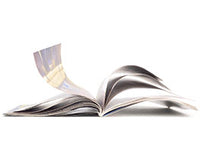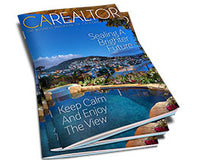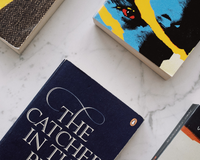What Is Magazine Paper & What Makes It Different?
Are you a magazine lover who can't resist the smooth feel of glossy pages?
Or perhaps you appreciate the subtlety of matte finishes? Whatever your preference, the type of paper used in magazines plays a significant role in the overall print quality. In this article, we will delve into the world of magazine paper and explore the different types available, from glossy to matte.
Glossy paper is known for its vibrant colors and high sheen, making images pop off the page and giving photographs a stunning, polished look. On the other hand, matte paper offers a more understated aesthetic with a non-reflective surface, providing a sophisticated and refined feel.
But the impact goes beyond aesthetics. The type of paper can affect how text and images are perceived, determining their clarity, sharpness, and detail. It also affects the tactile experience, influencing how readers interact with the magazine.
Join us as we dive deeper into the characteristics of glossy and matte paper, their advantages and disadvantages, and how they impact the overall print quality of magazines. Whether you're a magazine enthusiast or simply curious about the printing process, this article will satisfy your curiosity and give you a deeper appreciation for the world of magazine paper.
From Glossy to Matte: Exploring the Different Types of Magazine Paper and Their Impact on Print Quality
Glossy Paper: Features and Benefits
Glossy paper is known for its vibrant colors and high sheen, making images pop off the page and giving photographs a stunning, polished look. This type of paper is coated with a glossy finish, usually a clay coating that enhances the paper's smoothness and provides a reflective surface. The glossy coating not only enhances the colors but also adds depth and richness to images.
One of the major advantages of glossy paper is its ability to showcase high-resolution images with exceptional clarity and sharpness. The reflective surface helps to amplify the colors and details, creating a visually striking impact. Glossy paper is often used in fashion and lifestyle magazines, where vibrant and eye-catching visuals are essential.
However, there are a few downsides to using glossy paper. The reflective surface can sometimes lead to glare, making it challenging to read text in certain lighting conditions. Additionally, fingerprints and smudges are more noticeable on glossy paper, requiring extra care when handling the magazine.
On the whole, glossy paper offers a visually immersive experience that captivates readers with its vibrant colors and stunning images. It is a popular choice for magazines that aim to make a bold and impactful statement.
Matte Paper: Features and Benefits
In contrast to glossy paper, matte paper offers a more understated aesthetic with a non-reflective surface. This type of paper has a smooth texture but lacks the shine and sheen of glossy paper. Matte paper is often preferred for its elegant and sophisticated appearance, providing a more refined reading experience.
One of the key advantages of matte paper is its ability to reduce glare, making it easier to read text and view images from different angles and lighting conditions. The absence of a reflective surface also ensures that the focus remains on the content rather than any distracting reflections. Matte paper is commonly used in magazines that prioritize text-heavy content, such as news and literary publications.
Matte paper is also known for its excellent ink absorption, which results in crisp and sharp text. The lack of a glossy coating allows for a more natural and subdued color representation, giving photographs a softer and more subtle look. This paper type is often favored by photographers and artists who want to showcase their work with a touch of elegance.
However, it's important to note that matte paper may not offer the same level of color vibrancy as glossy paper.
The absence of a glossy coating can result in colors appearing slightly muted or less saturated. For magazines that rely heavily on vibrant visuals, glossy paper may be a more suitable choice.
Overall, matte paper provides a sophisticated and refined feel, creating a visually pleasing reading experience that allows readers to focus on the content without distractions.
Coated Paper: Features and Benefits
Coated paper refers to paper that has been coated with a layer of clay or other compounds to enhance its smoothness and print quality. Both glossy and matte paper fall under the category of coated paper, with the difference lying in the type of coating used.
The main advantage of coated paper is its ability to produce sharp and detailed images. The coating prevents ink from being absorbed too deeply into the paper fibers, resulting in crisper lines and finer details. Coated paper is commonly used in magazines that require high-quality image reproduction, such as photography and design publications.
There are different levels of coating available, ranging from light to heavy. Lightly coated paper offers a more subtle sheen and is suitable for magazines that aim for a balance between text and visuals. On the other hand, heavily coated paper provides a glossy finish that maximizes color vibrancy and image sharpness, making it ideal for magazines that prioritize visual impact.
However, one drawback of coated paper is its susceptibility to fingerprints and smudges. The coating can make the paper surface less absorbent, causing ink to sit on top and making it more prone to smudging. Care should be taken when handling magazines printed on coated paper to avoid leaving unwanted marks.
Coated paper offers excellent print quality and is favored by many magazines that want to showcase stunning images with exceptional clarity and detail. The choice between glossy or matte coating depends on the desired aesthetic and visual impact.
Uncoated Paper: Features and Benefits
Uncoated paper, as the name suggests, does not have any coating applied to its surface. This type of paper has a natural and textured feel, providing a tactile experience that appeals to many readers. Uncoated paper is commonly used in magazines that aim for a more organic and authentic look and feel.
One of the main advantages of uncoated paper is its ability to reproduce colors in a more subdued and natural manner. The absence of a glossy coating allows for a softer and more muted color representation, giving images a vintage or artistic quality. Uncoated paper is often favored by magazines that want to evoke a sense of nostalgia or create a more intimate reading experience.
Additionally, uncoated paper offers excellent writability.
The porous nature of the paper allows for easy absorption of ink, making it suitable for magazines that encourage readers to take notes or engage in interactive activities. Uncoated paper also tends to be more environmentally friendly as it requires less processing and chemicals compared to coated paper.
However, uncoated paper has its limitations. The lack of a coating means that the paper is more susceptible to ink bleed, where the ink spreads and blurs on the surface. This can result in slightly less sharp text and images compared to coated paper. Nevertheless, this characteristic can also add a unique and artistic touch to the overall aesthetic.
Uncoated paper offers a tactile and authentic reading experience, making it an appealing choice for magazines that want to stand out and create a connection with their readers.
Factors to Consider When Choosing Magazine Paper
When deciding on the type of paper for your magazine, several factors should be taken into consideration:
- Target audience: Understand your target audience and their preferences. Are they more likely to appreciate vibrant visuals or a more subdued aesthetic? Consider the demographic and interests of your readers to choose the paper type that will resonate with them.
- Content: Consider the nature of your magazine's content. Are you primarily featuring high-resolution images, or is text the main focus? Choose a paper type that complements and enhances your content, whether it's glossy for visually striking visuals or matte for a text-centric approach.
- Budget: Paper type can have a significant impact on printing costs. Glossy and coated paper tend to be more expensive compared to matte and uncoated paper. Consider your budget constraints and find a balance between print quality and affordability.
- Printing method: The type of printing method used can influence the paper choice. Certain printing techniques, such as offset printing, may require specific paper characteristics to achieve optimal print quality. Consult with your printer to ensure compatibility between paper type and printing method.
By carefully considering these factors, you can select the paper type that best suits your magazine's objectives and enhances the overall reading experience for your audience.
The Impact of Different Paper Types on Print Quality
The choice of paper type can significantly impact the overall print quality of a magazine. Each paper type has its unique characteristics that affect how text and images are perceived by the reader.
Glossy paper, with its reflective surface and vibrant colors, offers a visually immersive experience. The glossy coating enhances the colors and details, making images pop off the page. However, glare can be a concern, and fingerprints or smudges may be more noticeable.
Matte paper, with its non-reflective surface and elegant appearance, provides a more subdued but sophisticated reading experience. The absence of a glossy coating reduces glare and allows for easy readability from different angles and lighting conditions. The colors may appear slightly less vibrant but offer a more natural and artistic representation.
Coated paper, whether glossy or matte, offers excellent print quality with sharp and detailed images. The coating prevents ink from being absorbed too deeply into the paper, resulting in crisper lines and finer details. However, coated paper is more susceptible to fingerprints and smudges.
Uncoated paper, with its tactile and textured feel, creates a unique reading experience. It offers a softer and more muted color representation, giving images a vintage or artistic quality. However, it may be more prone to ink bleed and slightly less sharp text and images compared to coated paper.
Ultimately, the choice of paper type depends on the desired aesthetic, target audience, and content of the magazine. By understanding the characteristics and advantages of each paper type, you can make an informed decision that will enhance the print quality and overall reading experience.
Case Studies: Examples of Magazines Using Different Paper Types
To further illustrate the impact of different paper types on print quality, let's take a look at a few case studies of magazines that have made deliberate choices in their paper selection:
- Fashion Forward: A high-end fashion magazine that aims to showcase vibrant and visually stunning images of the latest fashion trends. This magazine opts for glossy paper to maximize color vibrancy and image sharpness, creating a visually captivating experience for its readers.
- Literary Oasis: A literary magazine that focuses on thought-provoking essays and poetry. This magazine values easy readability and a sophisticated aesthetic. It chooses matte paper to reduce glare and provide a more refined reading experience that allows the content to shine.
- Artistic Expressions: An art magazine that features a wide range of artistic works, including paintings, sculptures, and photography. This magazine selects uncoated paper to evoke a more organic and authentic feel, complementing the artistic nature of the content and creating a tactile reading experience.
These case studies demonstrate the importance of selecting the right paper type that aligns with the magazine's objectives and enhances the overall reading experience for its target audience.
How to Choose the Right Paper Type for Your Magazine
Choosing the right paper type for your magazine can be a daunting task, but by considering the following factors, you can make an informed decision that will enhance the print quality and reader experience:
- Define your magazine's objectives: Understand the purpose and goals of your magazine. Are you aiming for a visually striking publication or a more refined and elegant aesthetic? Clarifying your objectives will help guide your paper selection.
- Consider your target audience: Analyze your target audience's preferences and interests. Are they more likely to appreciate vibrant visuals or a more subdued aesthetic? Tailor your paper choice to resonate with your readers.
- Evaluate your content: Assess the nature of your magazine's content. Is it primarily image-based, text-heavy, or a combination of both? Choose a paper type that complements and enhances your content, ensuring optimal readability and visual impact.
- Understand the printing process: Consult with your printer to understand the technical requirements and limitations of different paper types. Certain printing methods may require specific paper characteristics to achieve the desired print quality.
- Consider budget constraints: Determine your budget for printing and factor in the cost implications of different paper types. Find a balance between print quality and affordability that aligns with your financial resources.
By taking into account these considerations and weighing the advantages and disadvantages of each paper type, you can make a well-informed decision that will elevate the print quality of your magazine and create an exceptional reader experience.
The Importance of Selecting the Right Paper Type for Print Quality
The type of paper used in magazines plays a crucial role in the overall print quality and reader experience. Whether you opt for the vibrant colors and high sheen of glossy paper or the refined elegance of matte paper, your choice will impact how text and images are perceived, as well as the tactile experience for readers.
Glossy paper offers a visually immersive experience with its vibrant colors and high sheen, making images pop off the page.
Matte paper provides a more subdued but sophisticated aesthetic, reducing glare and allowing for easy readability.
Coated paper, whether glossy or matte, offers excellent print quality with sharp and detailed images.
Uncoated paper creates a unique reading experience with its tactile and textured feel, offering a softer and more muted color representation.
When choosing the right paper type for your magazine, consider factors such as your target audience, content, budget, and printing method. By understanding the unique characteristics and advantages of each paper type, you can make an informed decision that will enhance the print quality and overall reading experience.
Delving into the World of Magazine Paper
For those fascinated by magazines or intrigued by the printing process, delving into the intricacies of magazine paper offers a richer understanding of its influence on the magazine's visual and tactile appeal. This exploration can deepen your appreciation for the meticulous choices behind each page, shaping how we experience the content both visually and physically. The next time you browse through your preferred magazine, pause to consider the paper quality. Observe its texture, weight, and finish, and appreciate the thoughtful craftsmanship that elevates your reading experience, transforming it into something visually captivating and engaging.
Printing on magazine paper at a digital printing company like PrintStar Booklets:
If you're considering short run magazine printing, the ideal choice is 60 lb gloss text. This paper weight gives your magazine a professional and polished appearance.
When you choose to print your short run magazines with a digital printing company, you'll have the option of using 60 lb gloss text. While some digital printing companies offer this paper weight, not all do. Many companies typically stock 80 lb gloss text as their thinnest paper option. At PrintStar Booklets, we refer to 60 lb gloss paper as the "ultra-thin gloss paper".
To clarify, when I mention a "digital printing company", I'm talking about companies that utilize digital printing presses. These presses heavily rely on computers and other digital technologies, making them ideal for short to mid-size print runs.
Get Instant Quotes – Custom Magazine Printing
A quick note: it's not practical to purchase a paper weight like 60 lb gloss text for home printing. This paper weight, when intended for digital printing, is usually sold in large (parent) sized sheets on pallets. Without the necessary equipment to cut these sheets, it's impossible to use this for home production.
Contact PrintStar Booklets for a Sample Kit:
PrintStar Booklets provides free paper sample kits, which include magazine samples. For expert advice on paper types, reach out to our customer service team at 858.566.2536
Ready to print your magazine?





